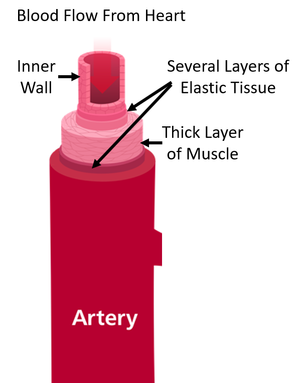Difference between revisions of "Artery"
| Line 30: | Line 30: | ||
:[https://www.amazon.co.uk/gp/product/0198359373/ref=as_li_tl?ie=UTF8&camp=1634&creative=6738&creativeASIN=0198359373&linkCode=as2&tag=nrjc-21&linkId=952a73bbb09d222ecc4b50d200679849 ''Arteries, pages 54-55, 141, GCSE Biology; Third Edition, Oxford University Press, AQA'] | :[https://www.amazon.co.uk/gp/product/0198359373/ref=as_li_tl?ie=UTF8&camp=1634&creative=6738&creativeASIN=0198359373&linkCode=as2&tag=nrjc-21&linkId=952a73bbb09d222ecc4b50d200679849 ''Arteries, pages 54-55, 141, GCSE Biology; Third Edition, Oxford University Press, AQA'] | ||
:[https://www.amazon.co.uk/gp/product/0008158754/ref=as_li_tl?ie=UTF8&camp=1634&creative=6738&creativeASIN=0008158754&linkCode=as2&tag=nrjc-21&linkId=27ad53b0283feeff7fc5ae04a9e205f54 ''Artery, pages 113, 205, GCSE Biology; Student Book, Collins, AQA'] | :[https://www.amazon.co.uk/gp/product/0008158754/ref=as_li_tl?ie=UTF8&camp=1634&creative=6738&creativeASIN=0008158754&linkCode=as2&tag=nrjc-21&linkId=27ad53b0283feeff7fc5ae04a9e205f54 ''Artery, pages 113, 205, GCSE Biology; Student Book, Collins, AQA'] | ||
| + | ====Edexcel==== | ||
| + | :[https://www.amazon.co.uk/gp/product/1292120193/ref=as_li_tl?ie=UTF8&camp=1634&creative=6738&creativeASIN=1292120193&linkCode=as2&tag=nrjc-21&linkId=572df39392fb4200db8391d98ae6314e ''Arteries, page 114, GCSE Combined Science, Pearson Edexcel ''] | ||
| + | :[https://www.amazon.co.uk/gp/product/1292120207/ref=as_li_tl?ie=UTF8&camp=1634&creative=6738&creativeASIN=1292120207&linkCode=as2&tag=nrjc-21&linkId=22455ff53961978667722edaa64c0be5 ''Arteries, page 166, GCSE Biology, Pearson, Edexcel ''] | ||
| + | :[https://www.amazon.co.uk/gp/product/1782948120/ref=as_li_tl?ie=UTF8&camp=1634&creative=6738&creativeASIN=1782948120&linkCode=as2&tag=nrjc-21&linkId=dedef775c6a43dbb0a609441525adac0 ''Arteries, page 264, GCSE Biology, CGP, Edexcel ''] | ||
| + | :[https://www.amazon.co.uk/gp/product/1782945741/ref=as_li_tl?ie=UTF8&camp=1634&creative=6738&creativeASIN=1782945741&linkCode=as2&tag=nrjc-21&linkId=30da4f2178da182547b62a7329d13b57 ''Arteries, page 62, GCSE Combined Science; The Revision Guide, CGP, Edexcel ''] | ||
| + | :[https://www.amazon.co.uk/gp/product/1782946748/ref=as_li_tl?ie=UTF8&camp=1634&creative=6738&creativeASIN=1782946748&linkCode=as2&tag=nrjc-21&linkId=a4f0348fc37d0ba1bb52d27f8679581f ''Arteries, page 90, GCSE Biology; The Revision Guide, CGP, Edexcel ''] | ||
Revision as of 11:31, 29 October 2019
Contents
Key Stage 3
Meaning
An artery is a blood vessel which carries blood away from the heart.
Key Stage 4
Meaning
An artery is a blood vessel which carries high pressure blood away from the heart.
Adaptations of Arteries
- Arteries have a thick layer of muscle to cope with the high pressure of the blood.
- Arteries have a several layers of elastic tissue which can stretch to cope with the high pressure of the blood.
| A diagram of an artery. |
About Arteries
- Most, but not all, arteries carry oxygenated blood.
References
AQA
- Arteries, page 31, GCSE Combined Science; The Revision Guide, CGP, AQA'
- Arteries, page 35, GCSE Biology; The Revision Guide, CGP, AQA'
- Arteries, page 77, GCSE Combined Science Trilogy; Biology, CGP, AQA'
- Arteries, page 83, GCSE Biology, CGP, AQA'
- Arteries, pages 51, 53, GCSE Biology, Hodder, AQA'
- Arteries, pages 51, 53, GCSE Combined Science Trilogy 1, Hodder, AQA'
- Arteries, pages 54-55, 141, GCSE Biology; Third Edition, Oxford University Press, AQA'
- Artery, pages 113, 205, GCSE Biology; Student Book, Collins, AQA'
